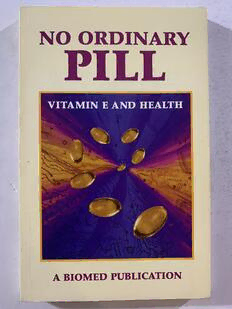Table Of ContentNO
ORDINARY
PILL
A
BIO^.Zr> i^ITKIICATION
Digitized by the Internet Archive
2010
in
http://www.archive.org/details/noordinarypillviOOpawl
No Ordinary
Pill
Vitamin E and Health
Editors:
Dr. Laura Pawlak
Dr. Michelle Albers
ABiomed General Publication
Emeryville, California
1999
No Ordinary
Pill
Vitamin E and Health
©
Copyright 1999 by Biomed General
5801 ChristieAvenue, Suite 280
Emeryville, California94608
USA
Tel: (510) 450-1657
Fax: (510) 450-1336
E-mail: [email protected]
Website: www.biomedbooks.com
Editors:
Dr. LauraPawlak
Dr. MichelleAlbers
ManagingEditor
RandyMalat
ISBN 1-893549-00-3
All rights reserved. Printed in the UnitedStatesofAmerica. No partofthis
bookmaybeusedor reproduced in anyform orbyanymeans, orstored in a
databaseorretrieval system,without thewritten permission ofthe publisher.
This book is not designed to substitute forprofessional medical advice.
Alwaysconsultamedical professional before makingmajorchanges in eating
habits ortakingsupplements.
Toobtain more information about BiomedGeneral'sproducts andservices,
pleasecontact us at theaboveaddress.
About the Editors
Dr. Laura Pawiak
Laura Pawiak (PhD, RD) received her master's in nutrition and
her doctorate in biochemistry at the University of lUinois. She
did her post-doctoral training in immunology at the University
ofCalifornia, San Francisco Medical Center. Dr. Pawiakhas taught
at the university level and is now in private practice. She is a
health and fitness instructor certified by theAmerican College of
Sports Medicine. The author of 22 publications, Dr. Pawiak
frequently lectures about nutrition to health professionals.
Dr. Michelle Albers
MichelleAlbers (PhD, RD) earnedhergraduate degrees in human
nutrition at Ohio State University. As an assistant professor at
the University ofSouth Florida College ofNursing, she taught
nutrition courses to nursing and non-nursing majors. She has
worked as a nutrition health educator at a hospital in Tampa,
Florida, and as a consulting nutritionist. Dr. Albers, the author
of numerous scientific and general articles, lectures at regional
and international nutrition conferences.
About Biomed General
Biomed General is an organization that provides health care
professionals with the latest scientific and clinical information.
Biomed's live seminars and home-study courses are designed to
help health professionals' provide better care for their patients.
An affiliate of the Institute for Natural Resources (INR),
Biomed General operates nationw^ide in the United States as well
as internationally.
For more information about the organization's seminars and
home-study courses, please contact:
Biomed General
5801 Christie Avenue, Suite 280
Emeryville, California 94608
USA
Tel: (510)450-1657
Fax: (510)450-1336
E-mail: [email protected]
Website: v^^v^^w.biomedbooks.com
Contents
Introduction
i
Chapter
1
The Nature and Function of Vitamin E 7
Chapter 2
Can Vitamin E Protect Cardiovascular Healtti? 21
Chapter 3
Vitamin E in Aging, Immune Power, and
Cancer Prevention 35
Chapter 4
Other Claims for Vitamin E 59
Chapter 5
What Can Affect "Need" for Vitamin E 81
Chapter 6
Sources of Vitamin E: Food and Supplements 101
Appendices
131
References
137
Index
151
Now vitamins D and A, B and C
Will ensure that you're happy and strong;
But that's no use; you must reproduce
Or the race won't last for long.
So vitamin E is the stuff for me
And its praises end my song.
my
We'll double the birth-rate yet, dears,
If we all eat vitamin E.
We can blast the hopes of Maria Stopes
By taking it with our tea.'
Introduction
Vitamin E is one ofthe most fascinating ofall the nutrients
under scientific scrutiny. Sometimes called an "anti-
aging vitamin," its claimed benefits are wide-ranging.
Vitamin E enthusiasts say it can do everything from protect
against heart disease and cancer to prevent wrinkled skin and
cure impotence. This book takes a look at the facts aboutvitamin
—
E what is known about its role in the body and what it can
and cannot do to safeguard health.
In 1922, University ofCalifornia, Berkeley researchers Drs.
Herbert Evans and Katherine Bishop identified a "substance X"
which restored fertility to sterile rats that had been reared on a
limited diet. Found to be present in lettuce, alfalfa, whole wheat,
and butterfat,"^ this newly-discovered nutrient was christened
tocopherol(horn the Greek tokos, childbirth, 2indpherein, to carry
or bring forth) and later identified as vitamin E.
No Ordinary Pill: Vitamin E and Health
Subsequent investigation showed that vitamin E is essential
to human health, though in ways which are still not fully
understood. It is best known as an antioxidant which protects
hpids and cells from oxidative damage and may help defend
against or slow the progression ofdisease. Contrary to the rhyme
quoted above and to vitamin E's scientific name, there is no
evidence that it is necessary for human reproduction. Nor does
the research show that vitamin E enhances sexual performance,
notwithstanding claims that it does.
In any case,—the vitamin is present in many foods,—and nearly
everyone's diet in the developed world, at least supplies
enough vitamin E to prevent what medical authorities consider
a deficiency'. It may take years ofstrict vitamin E deprivation to
deplete the body's reserves enough to cause any clinically-
significant symptoms.
Nonetheless, millions ofpeople find reason to take vitamin
E with their tea (or their breakfast;. U.S. sales of this popular
nutritional supplement more than doubled between 1991 and
1995 and have continued to rise by 10-15% yearly.
Manufacturers have sometimes been hard-pressed to meet
consumers' growing demand for vitamin E supplements.^"^
The reasons for avitamin E habit are numerous. Forexample,
some people take it daily because they think it's good for their
skin. Some use it topically to heal scars, treat sunburn, or soothe
cold sores; some believe it prevents wrinkles or helps control
varicose veins. Some are convinced that it's a "sexvitamin." Many
take vitamin E in order to strengthen their resistance to disease.
Vitamin E's mystique as a "fountain of youth" or antidote
to aging derives from research showing that it may help protect
against a number of illnesses most likely to strike older people.
For instance, individuals with higher consumption or blood levels
of vitamin E appear to be at lower-than-average risk for
2

